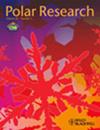Modelled realistic daily variation in low winter sea-ice concentration over the Barents Sea amplifies Asian cold events
IF 1.3
4区 地球科学
Q3 ECOLOGY
引用次数: 0
Abstract
The boreal wintertime atmospheric responses, especially cold events over central Asia, to low sea-ice concentration (SIC) with and without realistic daily variation over the Barents Sea are explored with the Community Atmosphere Model version 4.0 (CAM4.0). The results show that the general atmospheric responses to approximately equal winter-mean Arctic sea-ice loss with a similar pattern but with climatological versus realistic daily variation are different. With the forcing of low SIC with climatological daily variation, Asian cold events become a little longer and stronger than in the control experiment; this mainly results from the enhancement of a 500-hPa Ural anticyclonic anomaly. However, the low SIC forcing that includes realistic daily variability greatly intensifies central Asian cold events and the cyclonic anomaly downstream of the Ural anticyclone. Further analysis reveals that Asian cold events are closely associated with Arctic deep warming at an intraseasonal time scale, which is also the strongest in the perturbed experiment forced by low SIC with realistic daily variation. This work provides a better understanding of the linkage between sea-ice variation over the Barents Sea and central Asian cold events, which may improve extreme weather prediction. It also implies that it is necessary to force air–sea coupling models and atmospheric models with realistic daily SIC in the study of the relationship between Arctic sea ice and mid-latitude cold events.模拟的巴伦支海冬季海冰浓度低的真实日变化放大了亚洲的寒冷事件
利用社区大气模式4.0版(CAM4.0)探讨了北温带冬季大气对巴伦支海低海冰浓度(SIC)的响应,特别是中亚地区的寒冷事件,有和没有实际的日变化。结果表明,一般大气对冬季平均海冰损失的响应大致相同,具有相似的模式,但对气候日变化和实际日变化的响应不同。在具有气候日变化的低SIC强迫下,亚洲冷事件比对照试验时间更长、强度更强;这主要是由于一个500hpa的乌拉尔反气旋异常增强所致。然而,低SIC强迫(包括实际的日变率)极大地增强了中亚寒冷事件和乌拉尔反气旋下游的气旋异常。进一步分析表明,亚洲冷事件在季节内时间尺度上与北极深部变暖密切相关,并且在低SIC强迫的扰动实验中最强,且具有真实的日变化。这项工作提供了对巴伦支海海冰变化与中亚寒冷事件之间联系的更好理解,这可能会改善极端天气的预测。这也意味着在研究北极海冰与中纬度寒冷事件的关系时,有必要采用具有实际逐日SIC的海气耦合模式和大气模式。
本文章由计算机程序翻译,如有差异,请以英文原文为准。
求助全文
约1分钟内获得全文
求助全文
来源期刊

Polar Research
地学-地球科学综合
CiteScore
3.20
自引率
5.30%
发文量
22
审稿时长
>12 weeks
期刊介绍:
Since 1982, Polar Research has been the international, peer-reviewed journal of the Norwegian Polar Institute, Norway''s central institution for research, environmental monitoring and mapping of the polar regions. Aiming to promote the exchange of scientific knowledge about the Arctic and Antarctic across disciplinary boundaries, Polar Research serves an international community of researchers and managers. As an open-access journal, Polar Research makes its contents freely available to the general public.
Original primary research papers comprise the mainstay of Polar Research. Review articles, brief research notes, letters to the editor and book reviews are also included. Special issues are published from time to time.
The scope of Polar Research encompasses research in all scientific disciplines relevant to the polar regions. These include, but are not limited to, the subfields of biology, ecology, geology, oceanography, glaciology and atmospheric science. Submissions from the social sciences and those focusing on polar management and policy issues are welcome. Contributions about Antarctica are particularly encouraged.
 求助内容:
求助内容: 应助结果提醒方式:
应助结果提醒方式:


